S agalactiae group b - Study guides, Class notes & Summaries
Looking for the best study guides, study notes and summaries about S agalactiae group b? On this page you'll find 70 study documents about S agalactiae group b.
Page 4 out of 70 results
Sort by
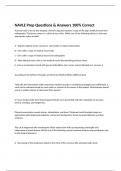
-
NAVLE Prep Questions & Answers 100% Correct
- Exam (elaborations) • 160 pages • 2023
- Available in package deal
-
- $12.99
- + learn more
A person calls to to say she adopted a friend's dog and requests a copy of the dog's medical record and radiographs. The former owner is a client at your clinic. Which one of the following choices is the most appropriate action to take? A - Require original owner consent or court order to release information B - Give caller a copy of medical record only C - Give caller a copy of medical record and radiographs D - After physical exam, start a new medical record documenting previous issu...
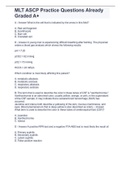
-
MLT ASCP Practice Questions Already Graded A+
- Exam (elaborations) • 31 pages • 2022
-
- $19.99
- + learn more
A What is the cell that is indicated by the arrow in this field? A. Red cell fragment B. Acanthocyte C. Burr cell D. Crenated cell D A young man is experiencing difficult breathing after fainting. The physician orders a blood gas analysis which shows the following results: pH = 7.25 pCO2 = 62 mmHg pO2 = 70 mmHg HCO3 = 23 mEq/L Which condition is most likely afflicting this patient? A. metabolic alkalosis B. metabolic acidosis C. respiratory alkalosis D. respir...
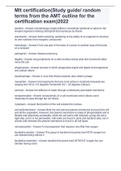
-
Mlt certification(Study guide/ random terms from the AMT outline for the certification exam)2022
- Exam (elaborations) • 27 pages • 2022
-
- $17.99
- + learn more
bacteria (microbiology) single-celled or noncellular spherical or spiral or rod-shaped organisms lacking chlorophyll that reproduce by fission autotrophic Self-nourishing; pertaining to the ability of an organism to produce its own nutrients from inorganic compounds heterotopic From one part of the body of a donor to another area of the body on a recipient pathogenic disease producing flagella long projections on a cell's surface whose whip like movement helps m...
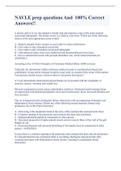
-
NAVLE prep questions And 100% Correct Answers!!
- Exam (elaborations) • 112 pages • 2023
-
- $10.99
- + learn more
A person calls to to say she adopted a friend's dog and requests a copy of the dog's medical record and radiographs. The former owner is a client at your clinic. Which one of the following choices is the most appropriate action to take? A - Require original owner consent or court order to release information B - Give caller a copy of medical record only C - Give caller a copy of medical record and radiographs D - After physical exam, start a new medical record documenting previous issu...
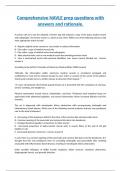
-
Comprehensive NAVLE prep questions with answers and rationale.
- Exam (elaborations) • 105 pages • 2024
-
- $13.39
- + learn more
Comprehensive NAVLE prep questions with answers and rationale. A person calls to to say she adopted a friend's dog and requests a copy of the dog's medical record and radiographs. The former owner is a client at your clinic. Which one of the following choices is the most appropriate action to take? A - Require original owner consent or court order to release information B - Give caller a copy of medical record only C - Give caller a copy of medical record and radiographs D - After p...
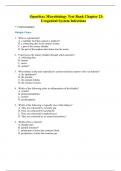
-
OpenStax Microbiology Test Bank Chapter 23: Urogenital System Infections
- Exam (elaborations) • 11 pages • 2024
-
- $16.39
- + learn more
OpenStax Microbiology Test Bank Chapter 23: Urogenital System Infections * = Correct answer Multiple Choice 1. What is a glomerulus? A. a capillary bed that contacts a nephron* B. a connecting duct in the urinary system C. a part of the urinary bladder D. the part of the nephron that drains into the ureter 2. Urine leaves the urinary bladder through which structure? A. collecting duct B. meatus C. ureter D. urethra* 3. What tube(s) in the male reproductive system transfer(s) sp...
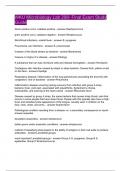
-
WKU Microbiology Lab 208- Final Exam Study Guide
- Exam (elaborations) • 2 pages • 2024
-
Available in package deal
-
- $8.99
- + learn more
Gram positive cocci, catalase positive - answer-Staphylococcus gram positive cocci, catalase negative - answer-Streptococcus Skin/throat infections, scarlet fever - answer-S. pyogenes Pneumonia, ear infections - answer-S. pneumoniae Invasion of the blood stream by bacteria - answer-Bacteremia Causes or origins of a disease - answer-Etiology A substance that can lyse red blood cells and release hemoglobin - answer-Hemolysin Contagious skin infection caused by staph or strep b...
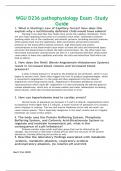
-
WGU Pathophysiology Study Guide: D236 Pathophysiology
- Exam (elaborations) • 25 pages • 2023
-
- $9.99
- + learn more
WGU Pathophysiology Study Guide: D236 Pathophysiology Lesson 1 TO Lesson 11 WGU Pathophysiology Study Guide: D236 Pathophysiology Lesson 1 TO Lesson 11: Pathophysiology Remediation Lesson 1: Homeostasis Concepts 1. Starling's Law of Capillary forces is the force behind the movements of fluid in capillary beds throughout the body. The two forces at work are hydrostatic and osmotic pressures. Homeostasis is achieved when these two forces are equal in the capillary- cell interfaces. When the hydro...

-
WGU Pathophysiology Study Guide: D236 Pathophysiology
- Exam (elaborations) • 25 pages • 2023
-
- $9.99
- + learn more
WGU Pathophysiology Study Guide: D236 Pathophysiology Lesson 1 TO Lesson 11 WGU Pathophysiology Study Guide: D236 Pathophysiology Lesson 1 TO Lesson 11: Pathophysiology Remediation Lesson 1: Homeostasis Concepts 1. Starling's Law of Capillary forces is the force behind the movements of fluid in capillary beds throughout the body. The two forces at work are hydrostatic and osmotic pressures. Homeostasis is achieved when these two forces are equal in the capillary- cell interfaces. When the hydro...
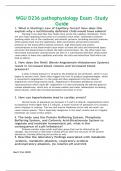
-
WGU Pathophysiology Study Guide: D236 Pathophysiology
- Exam (elaborations) • 25 pages • 2023
-
- $9.99
- + learn more
WGU Pathophysiology Study Guide: D236 Pathophysiology Lesson 1 TO Lesson 11 WGU Pathophysiology Study Guide: D236 Pathophysiology Lesson 1 TO Lesson 11: Pathophysiology Remediation Lesson 1: Homeostasis Concepts 1. Starling's Law of Capillary forces is the force behind the movements of fluid in capillary beds throughout the body. The two forces at work are hydrostatic and osmotic pressures. Homeostasis is achieved when these two forces are equal in the capillary- cell interfaces. When the hydro...

Did you know that on average a seller on Stuvia earns $82 per month selling study resources? Hmm, hint, hint. Discover all about earning on Stuvia


